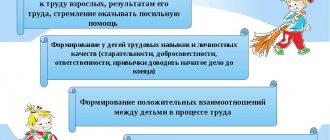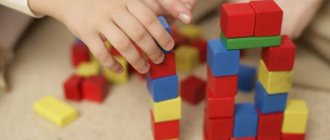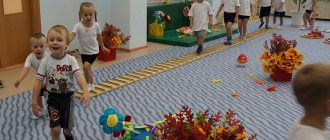Article on the topic: “The importance of play in the life of preschool children”
Play is a special activity that flourishes in childhood and accompanies a person throughout life. It is now generally accepted that play is the leading activity of a preschool child.
Play occupies a special place in the life of a preschooler. Researchers (L.S. Vygotsky, D.B. Elkonin, etc.) note that it is independent forms of play that are most important in pedagogy for a child’s development. In games, the child’s personality is most clearly revealed.
In theory, the game is viewed from various perspectives. The game is a way of exploring the world, because... a playing child creates his own world; the game has an impact on the overall mental development of the child; the game helps to assimilate social experience.
K.D. Ushinsky defined play as a feasible way for a child to enter into all the complexity of the adult world around him. Through imitation, the child reproduces and assimilates the basic aspects of human relationships. According to D.V. Mendzheritsky's game is designed to solve problems for the development of moral and social qualities, and the game should be developmental in nature and occurs under the control of an adult.
Despite the importance of play as a child’s all-round development, play is being replaced by educational activities. Parents devote most of their time to preparing their children for education.
Therefore, the best and proven means of forming a child’s personality of preschool age is the active activity of the child himself. The game has a number of advantages in this regard. It is an important means of control in the lives of children and provides a great opportunity for the manifestation of childish spontaneity, positive feelings and actions. The nature of role-playing and construction games contributes to the development of kind and conscious relationships in children. Mastering various rules helps regulate children's relationships.
A child needs active activities that help improve his vitality, satisfy his interests and social needs. The game is of great educational importance; it is closely connected with learning in the classroom and with observations of everyday life. In creative games, an important and complex process of mastering knowledge takes place, which mobilizes the child’s mental abilities, his imagination, attention, and memory.
With the development of interest in the work of adults, in public life, in the heroic deeds of Soviet people, children begin to have their first dreams of a future profession and a desire to imitate their favorite heroes. All this makes play an important means of creating the direction of a child’s personality, which begins to take shape in preschool childhood.
Conventionally, games can be divided into two main groups: role-playing games and games with rules.
Role-playing games are games on everyday topics, dramatized games, games - fun, entertainment.
Games with rules include didactic games and outdoor games.
The plot-role-playing game of a child is of a creative nature, where children take on roles and reproduce the activities and relationships of adults with you and the entertaining nature of the plot. In such games, children are capable of interesting inventions; they themselves add variety to this or that game. Children's initiative has a huge impact on the education of not only one child, but also the entire group.
Games with rules have a different purpose: they provide the opportunity for systematic exercises necessary for the development of thinking, feelings and speech, voluntary attention and memory, and various movements. Each game with rules has a specific didactic task, but ultimately, it is also aimed at solving basic educational problems. Didactic games are especially interesting for children because of their entertainment and content: guess, find, name. Children achieve results in the game, guided by certain rules. Interest in the quality of the game task is manifested: carefully fold the pattern, correctly, select a picture, and so on.
An interesting game increases the child’s mental activity, and he can solve a more difficult problem than in class.
But this does not mean that classes should be conducted only in the form of games. Training requires the use of a variety of methods.
The game gives good results only in combination with other methods: observations, conversations, reading, etc., because While playing, children learn to apply their knowledge and skills in practice.
Games with rules require generalization of knowledge and independent choice in solving a given problem.
Sometimes parents, wanting to raise their child to be very responsible and literate, strive to introduce him to educational activities as early as possible (for example, by hiring a tutor and “settling” him to study foreign languages), leaving no time for games, thereby reducing sociality in the child’s development . The child’s development becomes disharmonious (for example, the child can count and write very well, but turns out to be completely unable to establish contact with peers; in the worst case, the child may experience nervous strain, behavioral problems, obsessive fears, etc. may arise) .
It is in preschool age that the ability to behave in accordance with the roles assumed arises, which is very important for the further social development of the child.
The main activity of preschool children is play, during which the child’s spiritual and physical strengths are developed: his attention, memory, imagination, discipline, dexterity, etc. In addition, play is a unique way of learning social experience, characteristic of preschool age.
In play activities, many of the child’s positive qualities, interest and readiness for upcoming learning are formed, and his cognitive abilities develop. Play is important both for preparing a child for the future and for making his present life full and happy. To accomplish this task, it is necessary to create in kindergartens all the conditions for a variety of games, treat them carefully, respectfully, thoughtfully, and skillfully manage them.
By playing, children learn to live!
Literature:
1. Eremeeva V.D. Boys and girls. Teach in different ways, love in different ways. Neuropedagogy – for teachers, educators, parents, school psychologists. – Samara: Educational literature, 2005. – 160 p.
2. Gubanova N.F. Play activities in kindergarten. For working with children 2 – 7 years old. – M.: Mosaic – Synthesis. 2015. – 128 p.
3. Skorolupova O.A., Loginova L.V. LET'S PLAY?... LET'S PLAY!!! Pedagogical guidance of games for preschool children. – M.: “Publishing house Scriptorium 2003.” 2006. – 111 p.
Play activities of preschoolers in the light of the Federal State Educational Standard DO Article
Play activities of preschoolers in the light of Federal State Educational Standards for Preschool Education
The stage of preschool childhood plays a significant role in the manifestation of the child’s creative potential, the awakening of independence, the formation and development of a person’s personality as a whole. The decisive condition for the formation of a child’s individuality is his entry into a special dimension of childhood activity. The leading model of behavior and exploration of the world for a child is, of course, play. While playing, the child meets and communicates with other children, learns to make friends and build relationships, imitates adults, masters the unknown, learns what is good and what is bad. Below we will look at what conditions the Federal State Educational Standard prescribes when developing the play activities of preschoolers.
Modern play activities for preschoolers according to the Federal State Educational Standard
Children's games are not games at all, and it is more correct to look at them as the most significant and thoughtful activity of this age.
Michel de Montaigne
In the light of modern requirements, two possible ways of organizing play in kindergarten are identified. The first way lies in the influence of an adult on the content of the child’s story-based game, traditional for domestic pedagogy. In accordance with the second way, play is considered as an activity in which the child has the opportunity to realize his creative potential, that is, not only to reproduce and repeat what others have created, but also to act as a creator himself.
This is when the interaction of an adult with children is built on the basis of partnerships, i.e. the adult acted as the same play partner for the child as the other child. The basic principles of the concept of the gradual formation of ways of playing:
- In order for children to master gaming skills, an adult should play with them.
- starting from an early age and further at each stage of preschool childhood, when developing a child’s gaming skills, it is necessary to orient him to interaction with a peer partner, “provide” him with ways to coordinate actions with partners.
- an adult, playing with children throughout the entire preschool period, must, at each of its stages, develop the game in such a way that the child “discovers” and assimilates specific, gradually becoming more complex ways of constructing one or another type of game.
In paragraph 2.7 of the Preschool Education Standard, play is defined as a tool for organizing a child’s activities, his multifaceted development in the social-communicative, speech, cognitive, artistic-aesthetic and physical educational areas. The Federal State Educational Standard for Preschool Education indicates specific features of the gameplay of a preschooler, depending on the age category:
infant stage (two months - one year) - object play, acquaintance with the object world, acquisition of basic skills in manipulating objects, close emotional contact with family;
- early childhood (one to three years) - playing with combined and dynamic toys, communicating and playing with other children under adult supervision;
- preschool period (three to eight years) - a more complex plot-role format of play activity, a communicative game in compliance with certain rules.
Clause 4.6 of the Federal State Educational Standard for Educational Education stipulates the importance of developing gaming activities in the formation of social and normative foundations of a child’s behavior, as well as in increasing the efficiency of the educational process:
- Awakening interest - the learning process in a playful way entertains, brings pleasure and joy, neutralizes stress, turns knowledge of the world around us and the development of new practical skills into an exciting journey.
- Self-knowledge and self-realization - the baby gets to know his inner world, learns to show initiative, express his opinion in communication, rely on independence in design, make an informed choice of occupation and play partners;
- Forming a culture of cooperation - a joint game helps develop psychological skills of solidarity, teaches collective activity, the ability to hear not only oneself, but also one’s playing partners, is an excellent practical training in the art of conflict resolution and the ability to find a compromise, fosters respect for other people, develops a sense of justice and self-respect;
- Socialization - the child learns to distinguish between real reality and conditional reality (“make-believe”), develops the volitional qualities of self-discipline and understands the need to follow norms and rules;
- Development of communication skills - the baby masters such a tool as speech to solve the problem of mutual understanding and transfer of information.
- Play therapy helps in overcoming difficulties that arise in any area of the child’s activity.
Principles of organizing the game:
- a free form of child activity, excluding coercion, performed for the sake of obtaining positive emotions from the process itself, and not just from the final result of such activity;
- creative character, built on the principle of initiative, original improvisation and originality;
- emotional passion, manifested in the spirit of rivalry and competition;
- following rules that directly or indirectly reflect the logical sequence and meaningful design of the game.
Typology of play activity of preschoolers
Kinds
Games initiated by the children themselves (independent games):
- plot-display;
- role-playing game;
- director's production;
- theatrical improvisation.
Games born on the initiative of adults. Games with a pronounced educational character:
- didactic games with plot drawings;
- experimental game, travel game with search elements;
- moving at different levels of intensity;
- didactic games with musical accompaniment.
Games that are a form of relaxation or change of activity:
- entertaining games;
- intellectual puzzles and competitions;
- calendar and thematic holidays, carnival performances;
- theatrical costumes;
- folk games and folklore traditions that came to the modern world from the historical past.
Standalone game
At the age of three to five years, a child begins to discover the wonderful world of role-playing games, mastering the basics of role-playing, imitating the behavior of a character from the outside world. The basic basis of such a game is the plot; at this age, everyday scenes from family life become favorites. By first mastering the simplest manipulations with objects, later with their symbolic substitutes, then imitating the social roles of adults, the child improves the mechanisms of abstract thinking and undergoes playful practice in studying various models of behavior in society.
Plot-display game
Plot-based play appears from the age of three and precedes more complex plot-role play. The peculiarity of this game is that the child plays alone, the game actions are focused on the toy, but spiritually reflects the world of human relationships, emotions of joy or disappointment, lines of argument or approval, behavior of obedience or rebellion. Thus, the baby does not take on the role in full, but in play actions in relation to the toy he reproduces the model of behavior characteristic of a particular person. At the age of four or five years, the main characters in the game are still toys, but a more vivid emotional embodiment appears in gestures and facial expressions, dynamic poses of the child himself or the object. The so-called game attributes begin to acquire great importance, for example, a car for the driver, a pointer for the teacher, a doctor’s medical gown, a military cap, etc.
Director's play
Director's play is the least studied phenomenon; it has an exclusively individual character, when the child, acting as a director and screenwriter at the same time, comes up with words for the characters and himself plays their roles, being the author and actor in one person. You can often observe how a child, completely absorbed in building a house or playing with his favorite doll, acts out scenes between fictional characters and, pronouncing their words, does not seem to notice those around him.
Theatrical game
Based on a literary plot, children act out some scene using costumes or puppet theater characters (floor dolls or bibabo dolls), musical accompaniment or pantomime, choreography can be included, but then the help of adults is necessary. Such games teach children to read the mood or emotional state of another person by their facial expressions and gestures, develop a sense of empathy, teach them to understand and feel the people around them, and therefore build appropriate behavior. In addition, heroes are usually the fairy-tale embodiment of good and evil, light and dark forces, and as you know, good always defeats evil in the ending of a fairy tale. Such an unconditional victory of good attracts children and becomes the basis for optimism in life, stimulates the desire to imitate positive characters who are the embodiment of honor and nobility.
Role-playing game
For older preschoolers (6–7 years old), it will be important not to turn to a toy, but to communicate with children who play the role of heroes in the game plot. At this age, a child goes beyond everyday stories; he is inspired by larger-scale, “global” projects, for example, flying into space or traveling around the world, building a railway, etc.
Development under the conditions of the Federal State Educational Standard
The complication of a child’s gaming skill goes through three phases: first, adults are the initiators of the game and the authors of the plot plan, then only their prompt is required, and finally, the child improves his gaming skills to the level of complete independence. The child’s rich imagination and creative improvisation will make the game original and varied in its design, and therefore more interesting and exciting. In order for the games to be truly interesting and varied, serious work on the part of adults is required to involve the child in cognitive activity (clause 2.6 of the Federal State Educational Standard for Education). An erudite child with a developed understanding of the world around him for his age is bursting with new ideas, involving new participants in the game and filling it with deep content.
Basic requirements for effective organization and conduct of the game.
Two models of adult behavior:
- the adult is the inspirer, organizer and coordinator of the game based on a pre-prepared plot and available tools;
- the adult joins the spontaneous initiative of the children, occupying an equal position with the other players, and can influence the course of the game in ways common to all. He can suggest a new character, come up with a plot twist, etc.
Tasks of managing children's play activities:
- Stimulate playful reproduction of events in everyday life, thus achieving familiarity with the purpose of objects and mastering the skills of their practical use.
- Help to master the ability to see, understand and formulate the task of the game.
- To teach the search for various options for using toys during the game.
- Encourage the use of symbolic objects that replace real-life objects.
- Create game situations with fictional objects.
- To form the experience of replacing some game actions with images of a verbal form of expression.
- Arouse in children the desire to find different options for solving a game problem, using new combinations with objects.
- Develop independence in making decisions and searching for various tasks and goals of the game.
- Instill a gaming culture, i.e. teach to recognize the right of each participant to their own gaming space and respect the interests of all players.
- Stimulate the expression of keen interest in the games of peers.
- Learn to set a game task yourself and accept the task set by others.
- Encourage the invention of interesting and unusual game ideas.
- Teach the ability to negotiate.
An experiment game is a type of didactic game, an interactive form of conducting an educational lesson, during which visual modeling and imitation of the phenomena being studied are organized. Through experimental and research activities, a child gains new knowledge or acquires skills. “How does sound travel?” With the help of simple devices, such as a bowl of water or a small pool, coins or construction kit parts, the teacher invites children to understand the origin of the physical phenomenon of sound transmission. Children, throwing coins into a container of water, notice wavy circles spreading across the water. The teacher explains that sounds from the interlocutor or from another sound source reach us in the same waves, but through the air.
Rules of conduct for a teacher in the practical implementation of socio-game technology:
- absolutely exclude authoritarianism and dictatorship, except for those situations that may pose a potential danger to the health of children;
- take a democratic position on an equal basis with all participants in joint activities;
- keep a pause of non-interference and silence, such behavior will give children the opportunity to show independence in solving a problem or conflict;
- take into account the real capabilities of children, but try to expand the zones of independence, not chew knowledge and not give ready-made algorithms;
- help the child overcome shyness and uncertainty, having in the pedagogical reserve a set of exercises that will increase self-esteem and give confidence in their own abilities;
- moving away from a clear goal setting, it is more acceptable to create conditions for the discovery of the child’s intellectual and creative potential;
- during the presentation stage, give the first word to low-active children.
Clause 3.3.5 allows the educational organization to independently determine gaming equipment. According to the requirements of the Federal State Educational Standard for Education, the set of toys should be replenished gradually and periodically changed in accordance with the age and life experience of the children.
The skill of a teacher is most eloquently demonstrated in his ability to organize the independent activities of his students. The teacher needs to skillfully direct each child to an entertaining, but at the same time useful game, while it is important to rely on initiative and develop the child’s curiosity. An attentive and caring teacher will correctly distribute children among game tasks so that they do not interfere with each other, and will show sensitivity and fairness in resolving a conflict situation that arises during the game. Thus, the harmonious creative development of children depends on the level of professional training of the teacher.
Classifications of preschooler games
Play activity is a form of child activity aimed not at the result, but at the process of action.
and
methods of implementation
and characterized by the child’s acceptance
of a conditional
position (as opposed to his real life one).
There are various approaches to the classification of children's games, which differ from each other in the characteristics that serve as their basis.
The first classification was proposed by F. Frebel: according to ped. All games are divided : sensory, motor, mental.
Karl Gross proposed his classification, which was based on instincts, and divided games into experimental and special ones.
The following classification was proposed by J. Piaget, based on age periodization .
In modern pedagogical theory, play is considered as the leading activity of a preschooler. The leading position of the game is determined not by the amount of time devoted to the game, but by the fact that: it satisfies his basic needs; other types of activities arise and develop in the game; the game contributes to the mental development of the child.
In preschool pedagogy, all games are divided into 2 groups:
1. Creative games are invented by the children themselves: role-playing games, director’s games, theatrical games, construction games.
2. Games with rules are developed by adults: didactic games, outdoor games, folk games.
Role-playing games are created by the children themselves, with some guidance from the teacher. They are based on children's amateur activities. Sometimes such games are called creative role-playing games, emphasizing that children do not simply copy certain actions, but creatively comprehend them and reproduce them in created images and play actions.
In the practice of education, games with rules created for children by adults are also used. Games with rules include didactic, active, and fun games. They are based on clearly defined program content, didactic tasks, and focused learning. In this case, children’s independent activities are not excluded, but they are more closely combined with the guidance of the teacher. As children master the experience of play and develop the ability to self-organize, they also play these games independently.
Games differ in content, characteristic features, and the place they occupy in children’s lives, in their upbringing and education.
There are several groups of games that develop a child’s intelligence and cognitive activity.
Group I – object games, such as manipulations with toys and objects. Through toys - objects - children learn shape, color, volume, material, the animal world, the human world, etc.
Group II – creative games, role-playing games, in which the plot is a form of intellectual activity.
Classification of games (according to S.L. Novoselova)
The Education and Training Program in Kindergarten provides the following classification of games for preschoolers:
- plot-role-playing : the main task of the teacher is to teach children, tell them the plot of the game. For example, when inviting children to play in professions, the teacher asks the children what their parents do, and then gives them the opportunity to choose the plot of the game themselves. The guys, in an argument and proposals, come to the conclusion that there is an opportunity to play builders. These are games of “Ambulance”, “Hospital”, “Shop”, “School”, etc. The main thing in a role-playing game is its collective nature. It is during this kind of play that children learn to communicate, act in accordance with a certain role, voice this role, and express their opinions. The plot of the game is the sphere of reality that is reproduced by children. Depending on this, role-playing games are divided into
:
n Games based on everyday stories;
n Games on industrial and social topics;
n Games on heroic and patriotic themes;
n Games on themes of literary works, films, television and radio programs.
The structure of a role-playing game includes the following components:
n roles played by children during the game;
n play actions with the help of which children implement roles;
n game use of objects (real ones are replaced by game ones).







